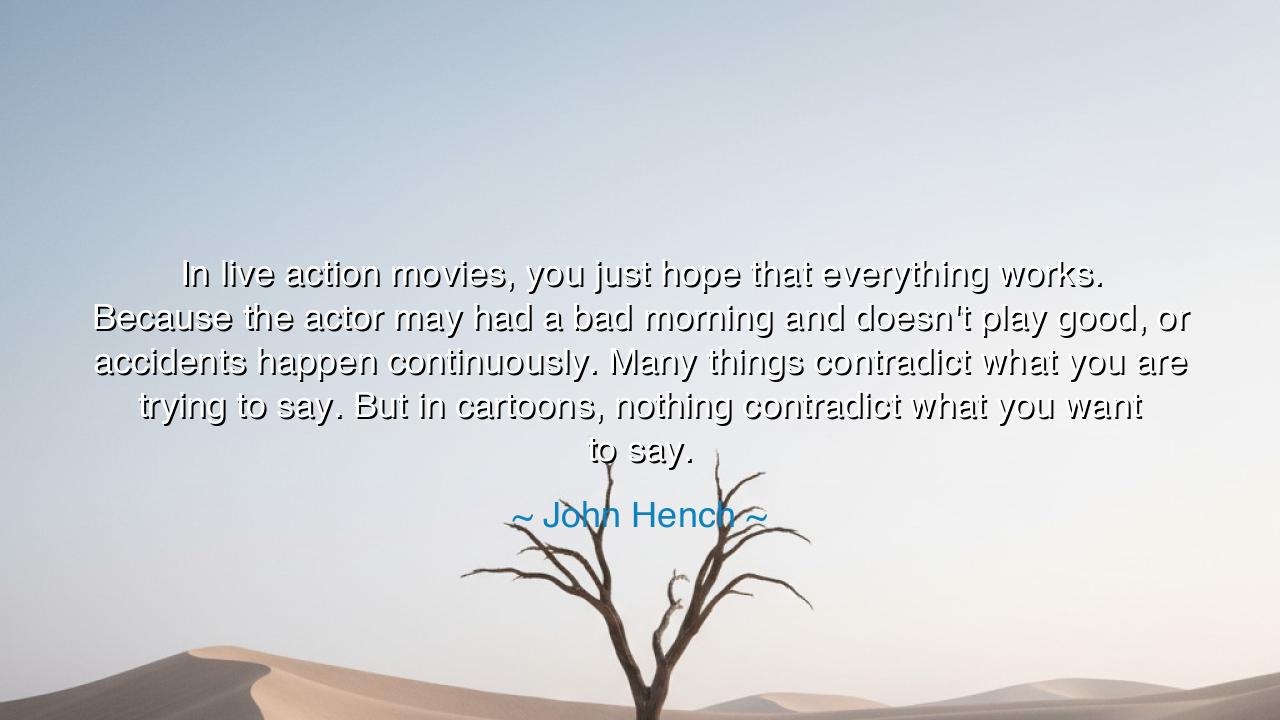
In live action movies, you just hope that everything works.
In live action movies, you just hope that everything works. Because the actor may had a bad morning and doesn't play good, or accidents happen continuously. Many things contradict what you are trying to say. But in cartoons, nothing contradict what you want to say.






In the wise and reflective words of John Hench, one of Walt Disney’s most trusted artists, there flows a truth that speaks not only to art, but to life itself: “In live action movies, you just hope that everything works. Because the actor may have had a bad morning and doesn’t play good, or accidents happen continuously. Many things contradict what you are trying to say. But in cartoons, nothing contradicts what you want to say.” In these words lies the timeless yearning of every creator — the desire for harmony between vision and reality, between what one dreams and what one can bring forth into the world.
The origin of this quote rests in Hench’s long career at Disney, where he helped shape some of the most beloved worlds of animation — from Fantasia to Cinderella, from Peter Pan to the very design of Disneyland itself. Working alongside Walt Disney, Hench saw firsthand the limits of live performance and the freedom of animation. In live action, the artist must wrestle with the unpredictability of life: a weary actor, a failing light, a sudden mishap — all can shatter the illusion. But in animation, the artist becomes as a god of creation, shaping each line, color, and motion to serve a single purpose. Nothing happens by chance; nothing stands apart from the story’s heart. To Hench, animation was not merely a technique — it was truth made pure, the perfect marriage of imagination and intent.
Yet beyond the world of film, Hench’s insight reveals something deeper — a lesson on the nature of control and imperfection. In the realm of human endeavor, life is like a live action film: unpredictable, filled with errors and interruptions. No matter how noble our intentions, accidents happen; emotions falter; others fail to see our vision. We are constantly at war with circumstance. But in the realm of the spirit — the inner world of imagination, art, and purpose — we can build like the animators do. There, every line can find its meaning, every motion can align with our ideal. The artist learns to accept that though reality resists perfection, the imagination remains its sanctuary.
The ancients understood this same truth. Plato wrote of the world of forms, the perfect realm beyond our flawed reality — where every idea exists in its purest shape, unbroken by the chaos of the material world. The live action world, like Plato’s shadowed cave, is full of contradictions and limitations, where even the best intentions are distorted by time and matter. But the world of animation, or creation of the mind, is akin to that higher plane — where everything serves the idea, and the idea is whole. Thus, Hench’s words become not merely a reflection on art, but a meditation on existence itself: reality will always oppose perfection, yet in our acts of creation, we can glimpse the divine.
Consider the story of Walt Disney himself — a dreamer who faced unending failure and resistance. His first studio went bankrupt. His early films were mocked. Even Snow White, now hailed as a masterpiece, was called “Disney’s Folly” before its release. Yet Walt continued to dream, because he saw beyond the world of accident and contradiction. He saw, as Hench did, that through animation, one could build a world untouched by human frailty — a world where hope could sing without interruption, where even a mouse could stand for courage, friendship, and faith. In the purity of those animated forms, he gave generations something true to believe in — a vision unmarred by cynicism or failure.
But let us not mistake Hench’s words as an escape from reality. To wish for a world without contradiction is not to deny the real, but to learn from it. The artist, like the philosopher, must labor in both worlds — the messy and the ideal. We must work amid imperfection, knowing that perfection can only exist in our vision, not in the dust of life. Yet it is that very vision that gives our labor meaning. When the world contradicts your truth, hold it still in your imagination, where it cannot be defiled. For though life may never be flawless, the spirit that imagines beauty keeps humanity alive.
So, my child of tomorrow, take this lesson from John Hench and the masters who came before him: the world will always be a live action stage, filled with broken lines, missed cues, and human flaws. But within you lies the power of animation — the inner art of shaping your reality through clarity, patience, and faith. When chaos rises around you, return to the world of your design, the place within where nothing contradicts your purpose. Build from there, again and again, until your truth shines through the imperfections.
For in the end, all creation — whether of art, of love, or of life itself — is a dialogue between accident and intention, between what is and what could be. The wise do not curse the flaws of the world; they use them as outlines to draw their vision more clearly. Thus, like Hench, learn to live in both worlds: to endure the grey unpredictability of life, yet never cease striving for the radiant perfection of your inner design. For though the world may contradict you, your imagination — your divine canvas — shall never fail you.






AAdministratorAdministrator
Welcome, honored guests. Please leave a comment, we will respond soon